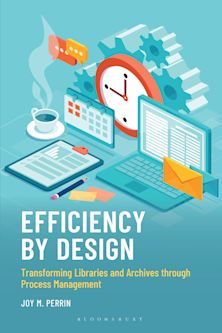Description
Innovative Practices for Archives and Special Collections
Description
Innovative Practices for Archives and Special Collections
This product is usually dispatched within 3 days
- Delivery and returns info
-
Free CA delivery on orders $40 or over
Description
Description: Innovative Practices for Archives and Special Collections explores how archives of different sizes and types can enhance the accessibility of their holdings. The book uses eleven case studies to demonstrate innovative ideas that could be transferred into many other settings.
Case studies cover
Crowdsourcing the Description of Collections Early Experiences with Implementing EAC-CPFConducting a Comprehensive Survey to Reveal a Hidden Repository Getting a Diverse Backlog of Legacy Finding Aids Online A Collaborative Standards-Based Approach to Creating Item-Level Metadata for Digitized Archival MaterialsCreating Policies and Procedures for Mandatory Arrangement and Description by Records CreatorsCollaboration in Cataloging: Sourcing Knowledge from Near and Far for a Challenging CollectionUsing LibGuides to Rescue Paper Ephemera from the Bibliographic UnderbrushDescribing Records, People, Organizations and Functions: The Empowering the User Project’s Flexible Archival Catalogue Integrating Born-Digital Materials into Regular Workflows Describing Single Items for Discovery and Access
These successful and innovative practices will help archivists and special collections librarians better describe their collections so that they can be successfully accessed and users can locate the right materials.
Readers can use these as models, sources of inspiration, or starting points for new discussions. The volume will be useful to those working in archives and special collections as well as other cultural heritage organizations, and provides ideas ranging from those that require long-term planning and coordination to ones that could be immediately implemented. It also provides students and educators in archives, library, and public history graduate programs a resource for understanding the variety of ways materials are being described in the field today and the kinds of strategies archivists are using to ensure collections can be found by the people who want to use them.
Table of Contents
1) “The Hive”: Crowdsourcing the Description of Collections
Zo? D'Arcy, National Archives of Australia
2) More Than a <biogHist> Note: Early Experiences with Implementing EAC-CPF
Erin Faulder, Veronica Martzahl, and Eliot Wilczek, Tufts University
3) Creating Access and Establishing Control: Conducting a Comprehensive Survey to Reveal a Hidden Repository
Matthew B. Gorham and Chela Scott Weber, Brooklyn Historical Society
4) Step by Step, Stage by Stage: Getting a Diverse Backlog of Legacy Finding Aids Online
Eira Tansey, Tulane University
5) You Got Your Archives in My Cataloging: A Collaborative Standards-Based Approach to Creating Item-Level Metadata for Digitized Archival Materials
Kelcy Shepherd and Kate Gerrity, Amherst College
6) A Long Road: Creating Policies and Procedures for Mandatory Arrangement and Description by Records Creators
Kristjana Kristinsdóttir, National Archives of Iceland
7) Collaboration in Cataloging: Sourcing Knowledge from Near and Far for a Challenging Collection
Evyn Kropf, University of Michigan
8) Where there’s a Will There’s a Way: Using LibGuides to Rescue Paper Ephemera from the Bibliographic Underbrush
Sharon Farnel, Robert Cole, Robert Desmarais, Spencer Holizki, and Jeff Papineau, University of Alberta
9) Describing Records, People, Organizations and Functions: The Empowering the User Project’s Flexible Archival Catalogue
Clare Paterson, University of Glasgow
10) Business as Usual: Integrating Born-Digital Materials into Regular Workflows
Jackie Dean and Meg Tuomala, University of North Carolina at Chapel Hill
11) Opening the Black File Cabinets: Describing Single Items for Discovery and Access
James Gerencser, Dickinson College
About the Editor
Index
Product details
| Published | May 22 2014 |
|---|---|
| Format | Paperback |
| Edition | 1st |
| Extent | 198 |
| ISBN | 9780810890930 |
| Imprint | Rowman & Littlefield Publishers |
| Dimensions | 229 x 152 mm |
| Series | Innovative Practices for Archives and Special Collections |
| Publisher | Bloomsbury Publishing |


































